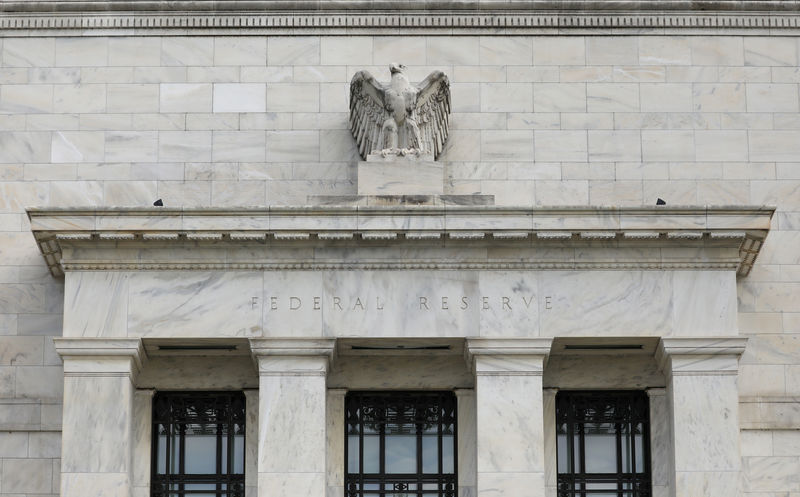By Howard Schneider
WASHINGTON (Reuters) - The Great Recession ended a decade ago this month, but for the U.S. Federal Reserve the fallout has posed an era-defining choice: Either jolt Americans to expect higher inflation, or keep the printing press ready for the next economic slide.
That politically fraught decision is the focus of a conference in Chicago this week to debate the risks and merits of two controversial strategies for thwarting a future downturn.
One is a hard sell: Convincing elected officials and households that higher prices today could produce more stable employment in the future.
The other would leave the Fed's current approach to inflation intact but means the next recession will likely require the bondbuying and unconventional strategies used to combat the last one, with less certain results and a political cost for the Fed.
"They are facing two potential outcomes, both of which are difficult," said Adam Posen, head of the Peterson Institute for International Economics and a moderator of one of the panels in Chicago. "The politically, but not economically, difficult one is that they manage to overshoot on inflation."
"The bigger concern is that we go into the next recession and we don't have ammo, you cut rates to zero and you do quantitative easing," Posen said. "That is the nightmare."
'FRAMEWORK' REVIEW 2.0
The Chicago conference is the central event in a yearlong series of meetings and research panels convened by Fed Chair Jerome Powell, who said he wanted to take advantage of a growing economy to review how the Fed tries to meet its twin goals of maximum employment and stable prices.
It is cast in technical terms as a review of the Fed's operating "framework," featuring many of the A-list economists and policy experts who often contribute to major Fed events.
Attention has centered on whether the Fed should make its 2% inflation target a goal to be reached on average.
That would mean tolerating higher inflation for long enough to offset years of weak price increases, leaving interest rates lower than might otherwise be the case and, as a benefit, keeping unemployment lower as well.
Effectively, it is an effort to refine work begun more than a decade ago under former Fed chair Ben Bernanke, who advocated monetary policy worked best if central banks publicly committed to a specific inflation target. That commitment, if backed by consistent policymaking, would shape public expectations and choices and help produce the desired level of inflation.
That led the Bernanke Fed in 2012 to adopt "flexible inflation targeting" with a formal inflation goal of 2%.
AN INFLATION 'MAKE-UP' STRATEGY
The years since have not been kind to Bernanke's framework.
Inflation, growth and interest rates have been stuck in low gear, a "new normal" that defied policymakers' forecasts for inflation to pick up following their stimulative efforts, particularly buying trillions of dollars in bonds.
The Fed's policy rate has been mired as well, currently in a range of 2.25% to 2.5% and unlikely to go higher. That is below historical averages, leaving the Fed less room to bolster the economy by cutting rates before it hits the zero lower bound and has to trot out the bond purchases and other tactics used to fight the 2007-2009 recession.
The aim of an inflation "make-up" strategy, considered risky and untested among the world's major economies, would be to shock inflation expectations higher, yielding the full benefits Bernanke had anticipated.
To some, it's an effort to better implement something the Fed could already do, if it took its current 2% goal more seriously.
Under Bernanke, some officials worried that if the Fed specified an inflation goal without defining "maximum employment," their bias would be to keep inflation in check and inevitably below target. The language agreed to then was meant to create what officials called a "big tent," attractive to policymakers worried about high inflation and those worried about high unemployment, allowing for a consensus.
It may have been too big.
"The issue really is that the Fed has not pursued its target with the aggressiveness one might want to see," said former Minneapolis Fed President Narayana Kocherlakota, who dissented against rate hikes at some of his last meetings because there was no apparent inflation pressure.
LEAN-IN TO FULL EMPLOYMENT?
Indeed the last two years have pushed even the most inflation-conscious officials toward a rethink.
Unemployment has fallen far further than policymakers expected without signs of rising prices, evidence that some basic dynamics in the economy have shifted.
To some, including Fed Vice Chairman Richard Clarida, that suggests the Fed could perhaps lean more heavily toward its maximum employment goal with less fear of inflation rising.
Two of the seven Chicago panels will examine what maximum employment means, a possible sign the Fed may acknowledge much higher levels of employment may now be possible before inflation kicks in.
Any decision will likely come next year, possibly in January when the Fed releases its annual statement of longer-run goals and strategy.
"This is not a purely intellectual exercise," said Dartmouth economics professor and former Fed adviser Andrew Levin. "The Fed should not be satisfied with how things went the last 10 years."
"It was a long, slow painful recovery. To the extent that was tough for a lot of American families you should not be complacent that you can do the same thing again."
